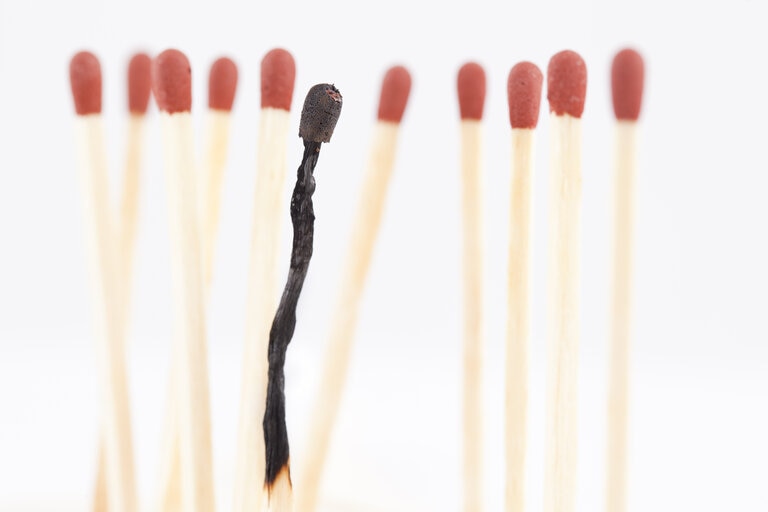Symptoms of burnout at work for doctors
The symptoms of burnout for doctors generally fall into three different areas. Here is a typical scenario that we often get in our practice.
John was yearning for the weekend despite it being the start of the week.
He’d been experiencing a sense of unease at the hospital he had worked at for a few months, but he couldn’t quite pinpoint the cause. He was always fatigued, struggling to remain engaged and motivated, and kept checking the clock to see when he could leave.
John had also started to become irritable with his fellow doctors and nurses, and was starting to feel unsympathetic to the patients in his care. This was so uncharacteristic of him. He also felt overwhelmed with tasks, leading to a constant feeling of being behind and demoralised.
John’s behavior is indicative of classic burnout symptoms. This article will explore the definition of burnout, its effects, and practical ways to prevent it from occurring for you.

Signs and Symptoms of burnout at work
Burnout at work is defined by the experience of:
- Emotional exhaustion. For most authors, exhaustion is a key component of burnout. Some signs of emotional exhaustion may be easily irritated or frustrated, feeling drained and depleted after shifts, and feeling at the end of your tether. In the scenario above you could see that John was feeling more fatigued and started to do a lot of clock-watching.
- Depersonalisation. This may look like a lack of empathy and a 'dehumanisation' in interpersonal relations. Some burnout signs of depersonalisation include low levels of patience, a disconnection from colleagues, and a lack of sensitivity and caring to others in the workplace. You could see this in the scenario above where John is displaying less patience with his colleagues and a less caring attitude towards his patients.
- Reduced personal accomplishment. This area looks at the demotivating effects of a difficult, repetitive situation leading to failure. Here the person is likely to feel a sense of hopelessness about the ability to accomplish things. Circling back to the scenario again, you can see that John is feeling overwhelmed and demoralised.
Burnout has reached epidemic levels among doctors, with global prevalence rates of clinician burnout ranging from 25–75%, and Australian levels ranging from 65–75% (Health and Wellbeing of Doctors and Medical Students, 2020).
Some causes of burnout for doctors
There are many reasons why doctors might reach the burnout stage.
These include:
- a lack of control
- unclear job expectations
- dysfunctional work dynamics
- lack of social support
- struggling to balance work with other responsibilities.
According to Daniel Tawfik and colleagues’ article published in the Current Treatment Options in Pediatrics (2019), there’s plenty of research showing that organisational factors, policies, and culture influence burnout rates in doctors and physicians.
We agree – the system lets doctors down.
Burnout has a serious impact on productivity and wellbeing. Burnout leads to increased medical errors, reduced work hours, and increased suicidal ideation; therefore, we all have a vested interest in preventing burnout.
To care for patients, doctors must maintain their health and wellbeing; and one avenue is to enhance resilience. That said, if you haven't got time to change the world, we want to give you strategies to cope at a personal level.
How to reduce burnout you can implement at the personal level
Burnout and stress are not the same things. However, increasing your resilience can help to reduce the chances of chronic stress and burnout.
Resilience is not an immutable skill that you bring into the world with you. It's something that you can grow and maintain. If you can build or maintain your already high levels of resilience, you're better able to manage the challenges that work and life are likely to throw at you. According to the American Medical Association, resilience gives you skills to reduce your chance of burnout, help you be a better doctor, and pass your upcoming exams.
The doctors we meet are under unrelenting stress, and often they see resilience as making them tougher. But this is not true.
In our work with doctors we focus at the personal level on their resilience. Resilience is about helping see the stressors in your world and responding to those stressors with a minimal psychological or physical cost.
- Examine your stressors and coping strategies. Here we examine the things causing your stress and then optimise your strategies you use to reduce the impact of these stressors.
- Increase the pause between stimulus and response. Victor Frankl, a Holocaust survivor and author of Man's Search for Meaning, said that "between stimulus and response there is a space. In that space is our power to choose our response. In our response lies our growth and our freedom." Here we introduce formal and informal ways that doctors can do this on the run to boost real-time resilience.
- Examine and challenge common thinking traps that could increase stress, anxiety and burnout. Some thinking traps that we've found particularly common for junior doctors, especially in their lead-up to exams, are black and white thinking, catastrophising, emotional reasoning, mind reading, and over generalisation.